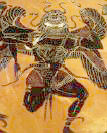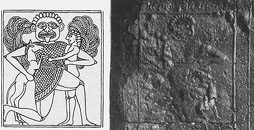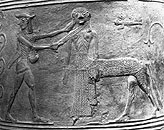Gorgo (Medusa)



A monster whose look could turn men to stone. She was decapitated by the
hero Perseus, and the head alone (Gorgoneion) becomes a symbol to frighten or protect. Gorgo is shown winged, with lion jaws and snakes in her hair; later, her face becomes that of a beautiful woman, but still with the snake hair. The head is often used in art in positions that
reflect its power, and appears at the centre of
Athena's
aigis. In early art she may appear with a horse's body. She had mated with
Poseidon, as a horse, and bore
Pegasos and Chrysaor at the moment of her death. She has sisters who pursue
Perseus, escaping with the Gorgo head; they are also known as Gorgons (Sthenno and Euryale).
Above left: Details from an Athenian black-figure clay vase, about 540 BC. London, British Museum B471. © British Museum Licence Plate 11 UK 1007 145
Above middle: Bronze shield band, 6th century BC, and sketch. Berlin Archeological Institute B1687 © Archeological Institute. Berlin Licence Plate 11 UK 1007 146
Above right: Detail from the neck of a Cycladic relief amphora. Paris Musée du Louvre CA 795. Photo. Chuzeville © Musée du Louvre


